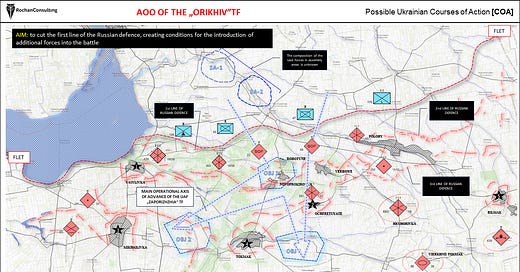1. Ukrainian Black Sea Depression as the Area of Operation [AOO]
The Ukrainian Black Sea Lowland, also known as the Pontic Lowland, is a geographical region located along the northern coast of the Black Sea in Ukraine. It stretches from the Danube River delta in the west to the Crimea Peninsula in the east. The region is characterised by its flat and low-lying terrain, with rich agricultural lands and extensive steppe grasslands.
Another feature of the Ukrainian Black Sea Lowland is that the Dnipro River divides the lowland into two parts, serving as the main geographical obstacle that limits the manoeuvring capabilities of military forces.
The Dnipro River also determines possible directions for conducting offensive operations, with the greatest potential for success being in the Zaporizhzhia-Melitopol direction.
Kyiv tried to overcome these obstacles. Ukrainians tried to infiltrate the river to liberate territories in the Dnipro Delta. Not only did Ukrainian SOF conduct multiple raids and attacks on Russian targets south of Kherson, but Ukrainian land forces formations also recaptured some land on the Ostriv Velykyi Island in May.
However, the destruction of the Nova Kakhovka dam effectively forces Ukrainians to cease operations in this area for the foreseeable future.
2. Transport infrastructure in the Southern Direction
An additional factor shaping the potential for gaining an advantage in a given direction
is a well-developed road and rail network. They facilitate offensive operations along the transportation lines and enable shifting the operational CENTER OF GRAVITY [COG], if necessary. They also facilitate the manoeuvrability of support units, particularly artillery, significantly enhancing their readiness to deploy and ability to conduct sustained fires.
In this case, a well-developed road network dramatically contributes to the increased longevity of support units. Additionally, a well-established road infrastructure promotes a smooth execution of the logistical support process for fighting forces.
Railway lines enable the implementation of logistic support for combat forces. In the case of the Armed Forces of the Russian Federation [RF], they play a significant role at the operational level [army]. Disabling the TKOMAK- DONETSK railway line will further burden the logistical system of the Russian combat forces.
3.Hydrography as a factor conditioning the conduct of operations in the area of operation
The hydrography of the operational area is the next significant factor that determines the direction of operations.
The most favourable conditions for conducting offensive operations, without the need to overcome water obstacles, are in the Zaporizhzhia-Melitopol direction.
4. The operational situation as of 14 JUN
We assess that:
The Political (Strategic) Goal Of The Russian Federation: is to keep Ukraine out of Western structures, defeat its military potential and ability to counterattack, and occupy the Luhansk and Donetsk Oblasts;
Current Military Objective: To stop the Ukrainian offensive and create conditions for a counterattack;
The core of the operation: Using tactical reserves to engage Ukrainian units involved in the ongoing counteroffensive.
The Russian order of battle is depicted on slide No. 5.
To achieve the set objective, the Armed Forces of the Russian Federation have deployed the combat formation outlined in slide No. 6.
ORKHIV direction:
1st Echelon units:
429th Motor Rifle Regiment, 503rd Motor Rifle Regiment, 22nd Spetsnaz Brigade, 45th Spetsnaz Brigade, 70th Motor Rifle Regiment, 177th Naval Infantry Regiment, 64th Motor Rifle Brigade, 114th Motor Rifle Regiment
2nd Echelon units:
291st Motor Rifle Regiment, 38th Motor Rifle Brigade
Support units:
439th Rocket Artillery Brigade, 291st Artillery Brigade, 292nd SPH Regiment
Operational Reserve units:
693rd Motor Rifle Regiment, 69th Tank Brigade.
VELYKA NOVOSILKA direction:
1st Echelon units:
60th Motor Rifle Regiment, 37th Motor Rifle Brigade, 71st Motor Rifle Brigade, 78th Motor Rifle Regiment
2nd Echelon units:
[no data]
Support units:
50th SPH Regiment
Operational Reserve units:
[no data]
5. Possible Ukrainian COA in the SD as a Center of Gravity [COG] of the operation
The main effort of the Ukrainian offensive operation has likely been focused on the Southern Ukraine direction [ORIKHIV and VELYKA NOVOSILKA].
ORKHIV axis [the tactical situation is shown on slide No. 8].
1st Echelon units:
128th Mountain Assault Brigade, 65th Mechanised Brigade, 47th Mechanised Brigade, 21st Mechanised Brigade, 115th Territorial Defense battalion
2nd Echelon units:
[no data]
Support units:
44th Artillery Brigade, 55th Artillery Brigade
Operational Reserve units:
118th Mechanised Brigade, 116th Mechanised Brigade
VELYKA NOVOSILKA axis [the tactical situation is shown on slide No. 9].
1st Echelon units:
115th Territorial Defence Brigade , 114th Territorial Defence Brigade, 102nd Territorial Defence Brigade, 108th Territorial Defence Brigade, 110th Territorial Defence Brigade, 128th Territorial Defence Brigade, 23rd Mechanised Brigade, 31st Mechanised Brigade, 68th Motorized Brigade, 37th Naval Infantry Brigade, 35th Naval Infantry Brigade, 4th Tank Brigade
2nd Echelon units:
[no data]
Support units:
47th Artillery Brigade
Operational Reserve.
33rd Mechanised Brigade, 71st Jager Air Assault Brigade, 46th Air Assault Brigade, 53rd Mechanised Brigade, 1st Tank Brigade, 117th Mechanised Brigade
6. Conclusions
The likely objective of the Ukrainian offensive is to sever the Russian defensive formations along strategically favourable directions, based on the terrain configuration and along the contact line between Russian operational groupings;
Ukraine likely can potentially breach the Russian defence only on one axis;
The centre of gravity of Ukrainian operations is in the VELYKA NOVOSILKA axis;
Breaking through the Russian defence will require an increased deployment of manoeuvrer formations and artillery fire support.













